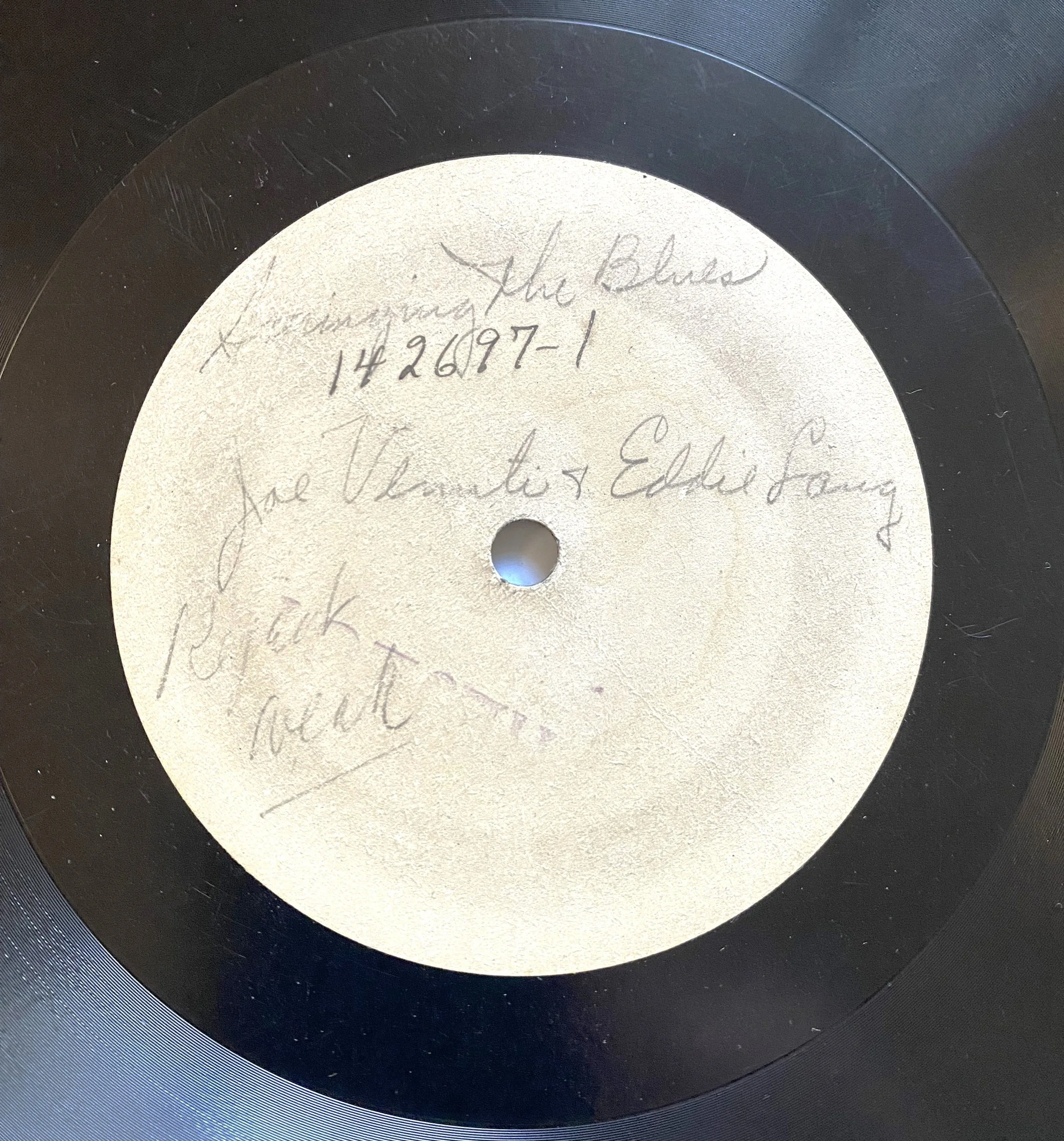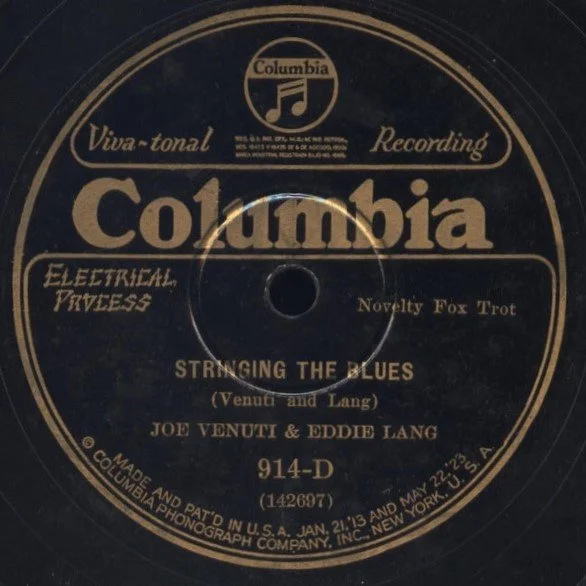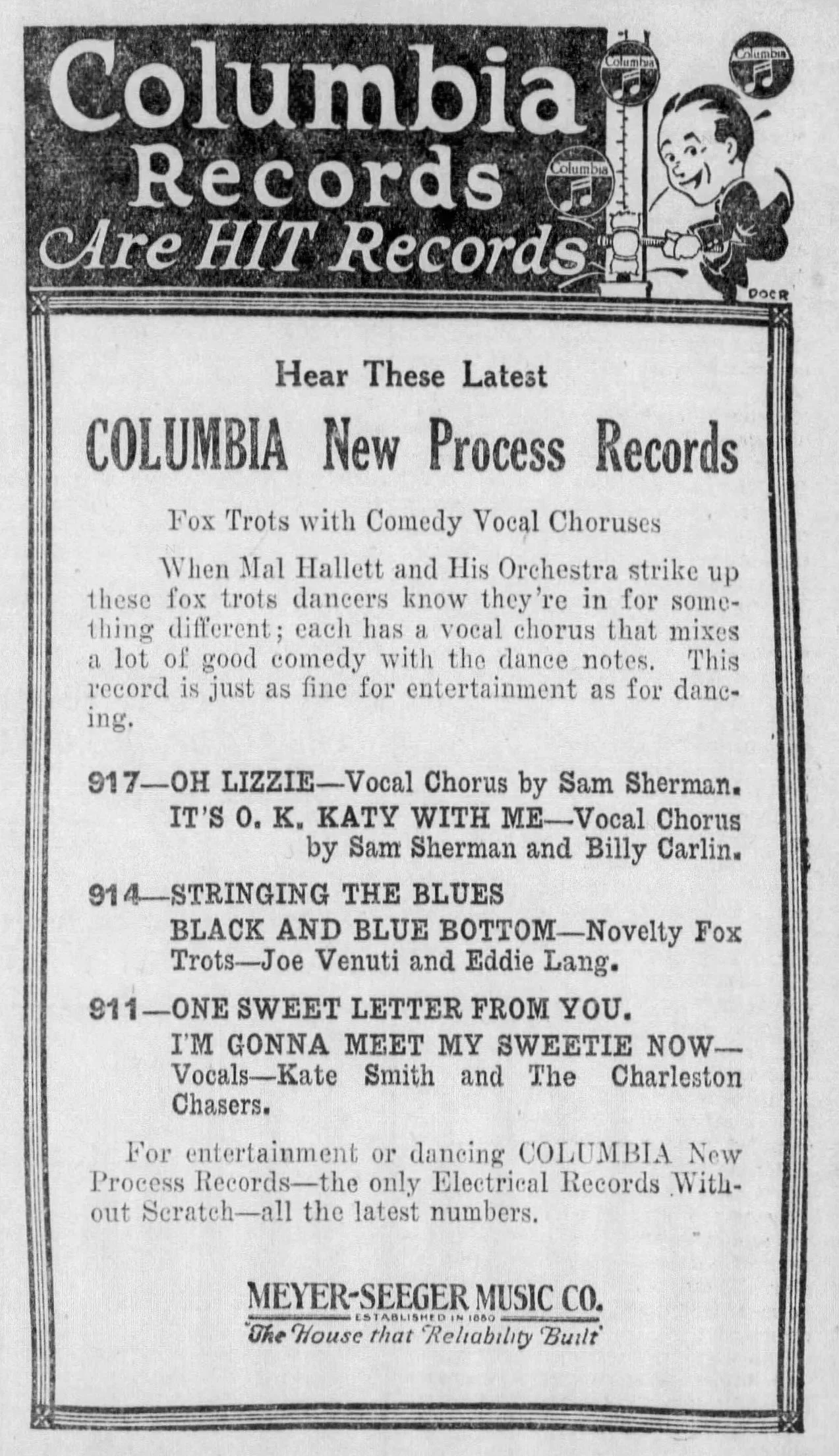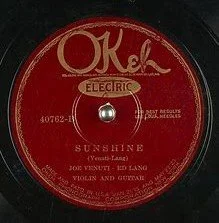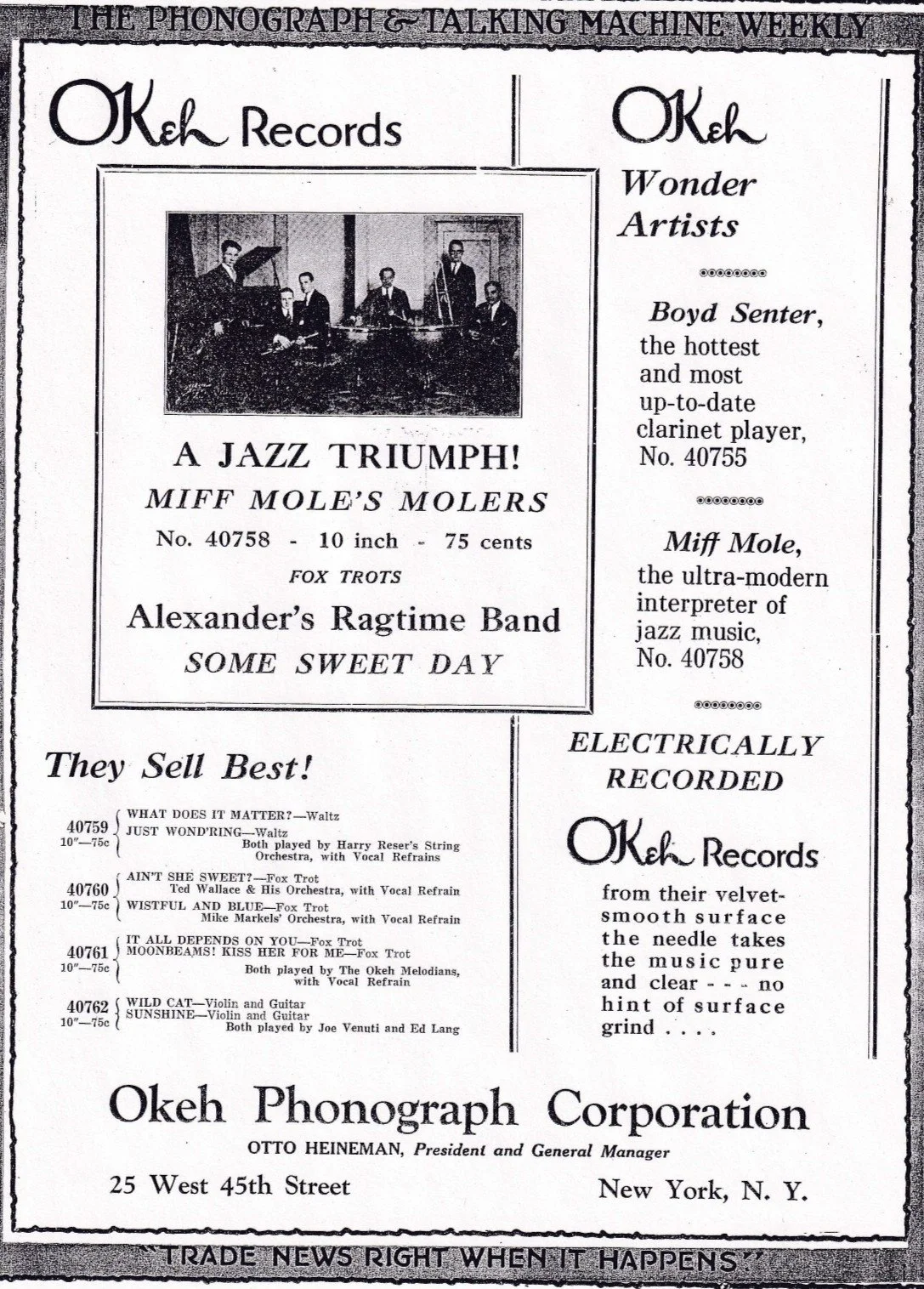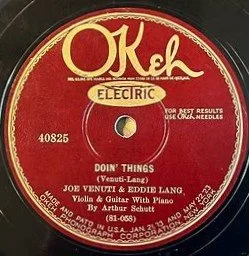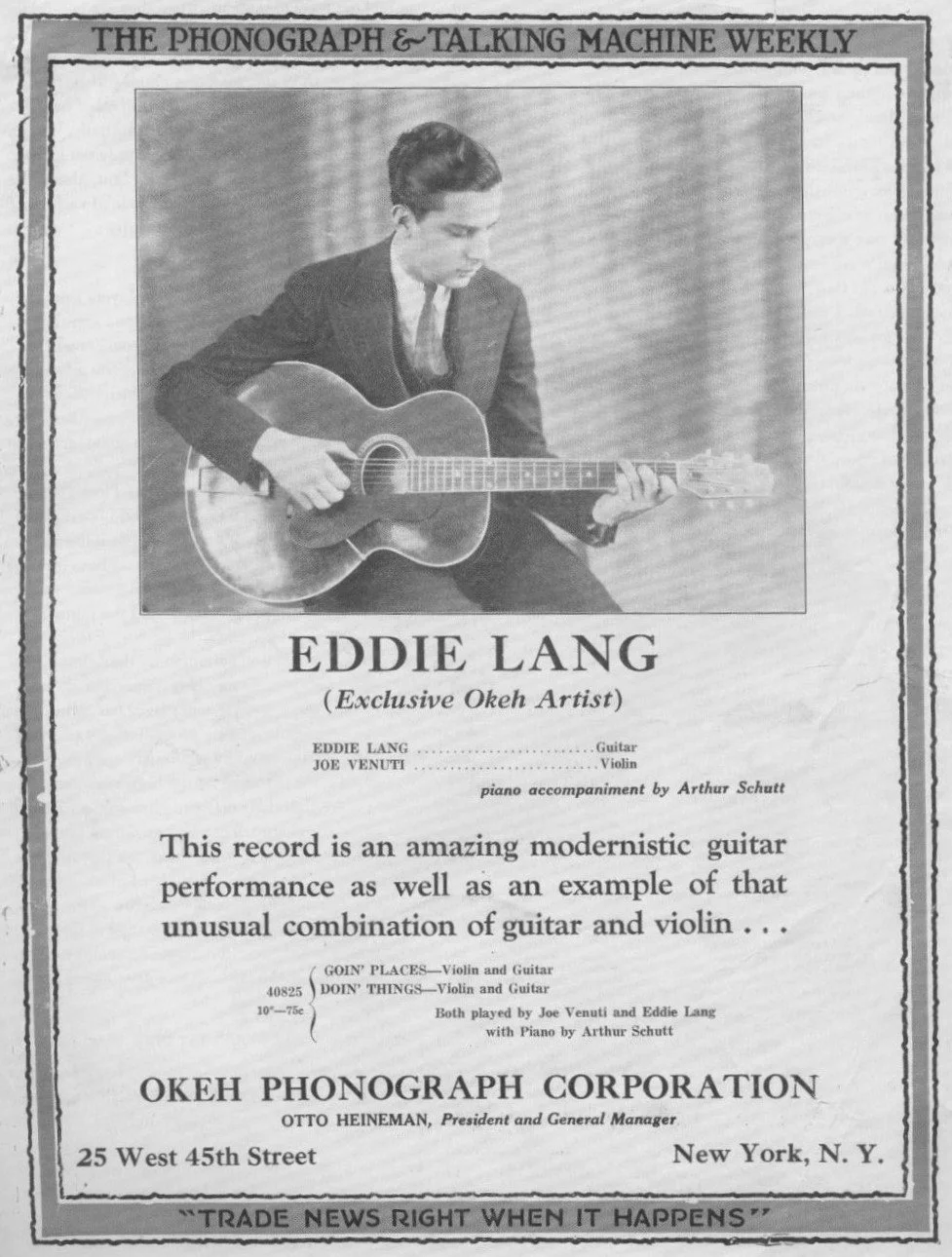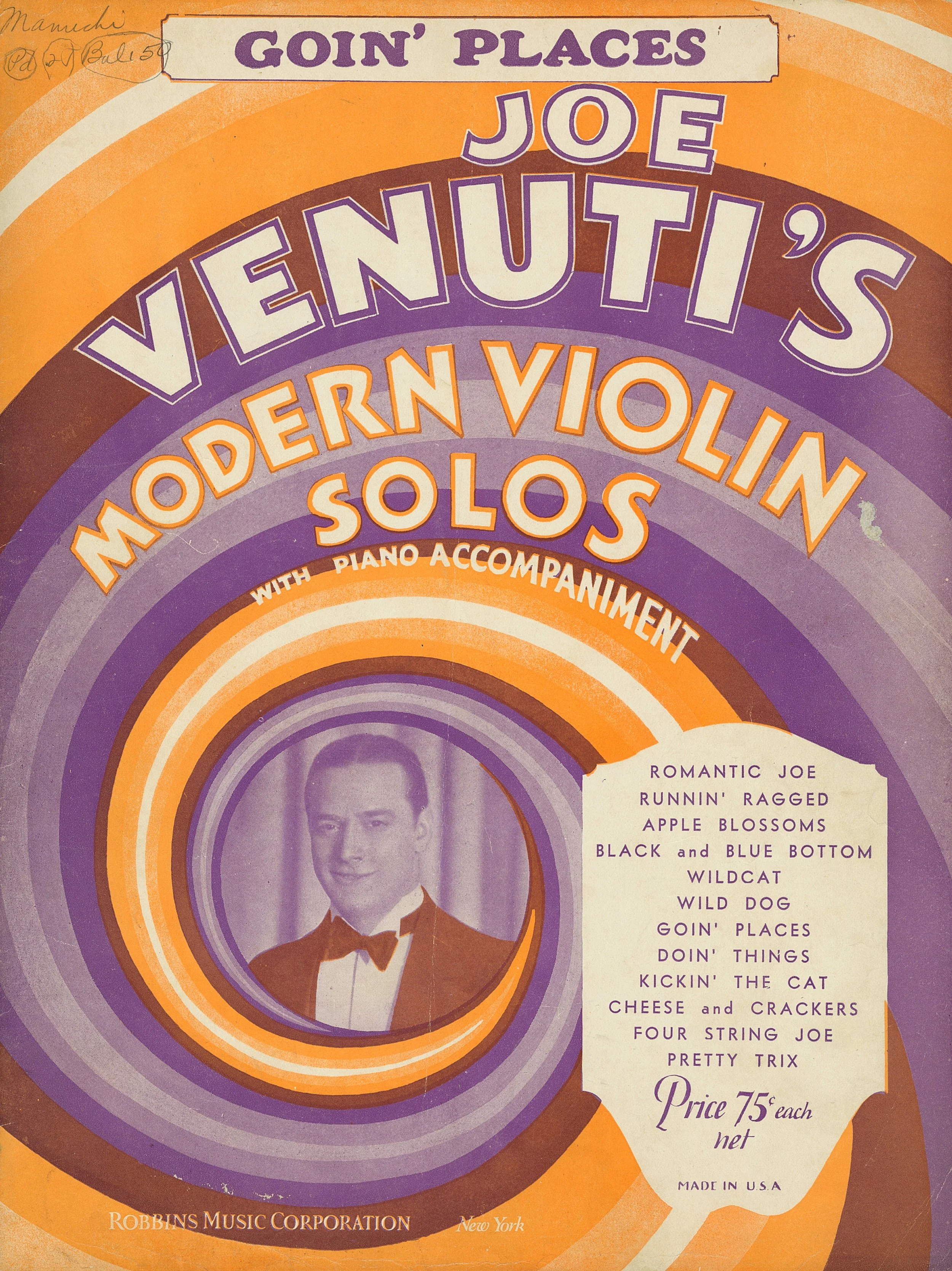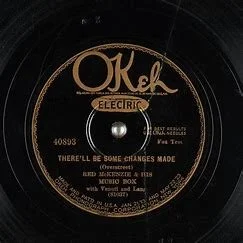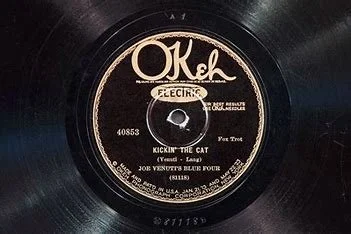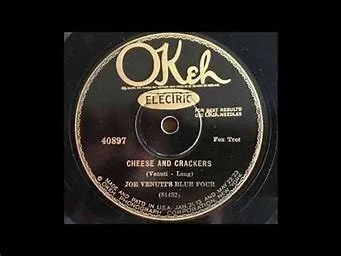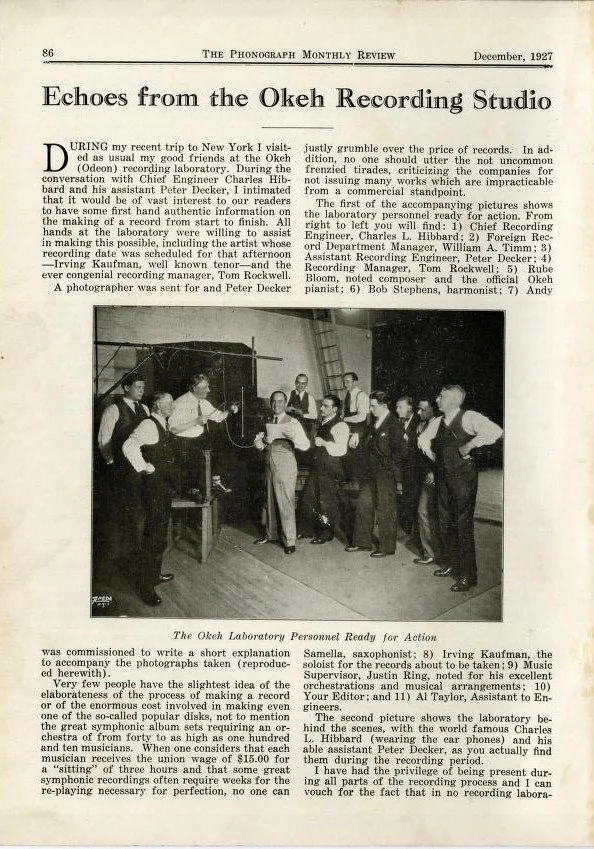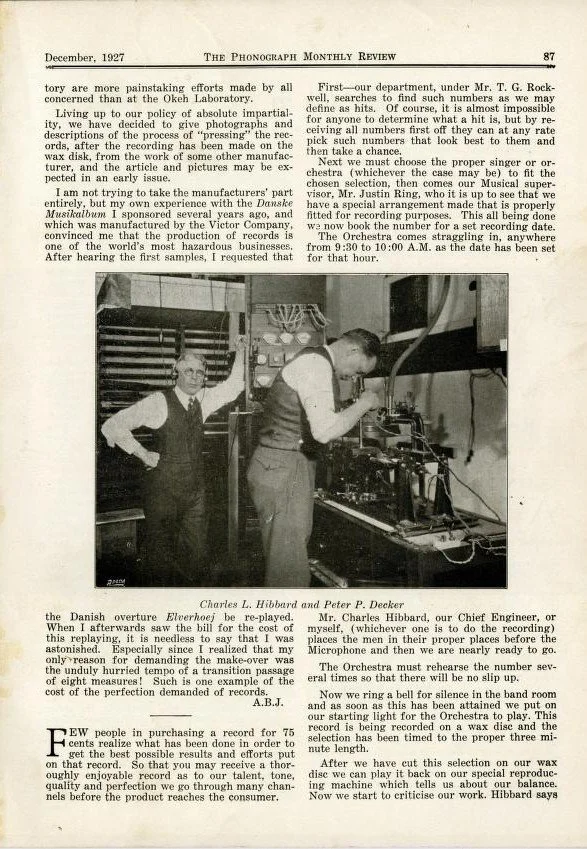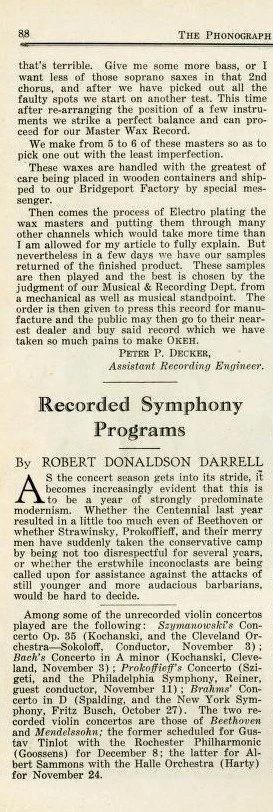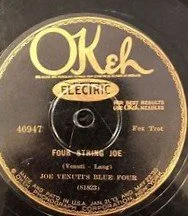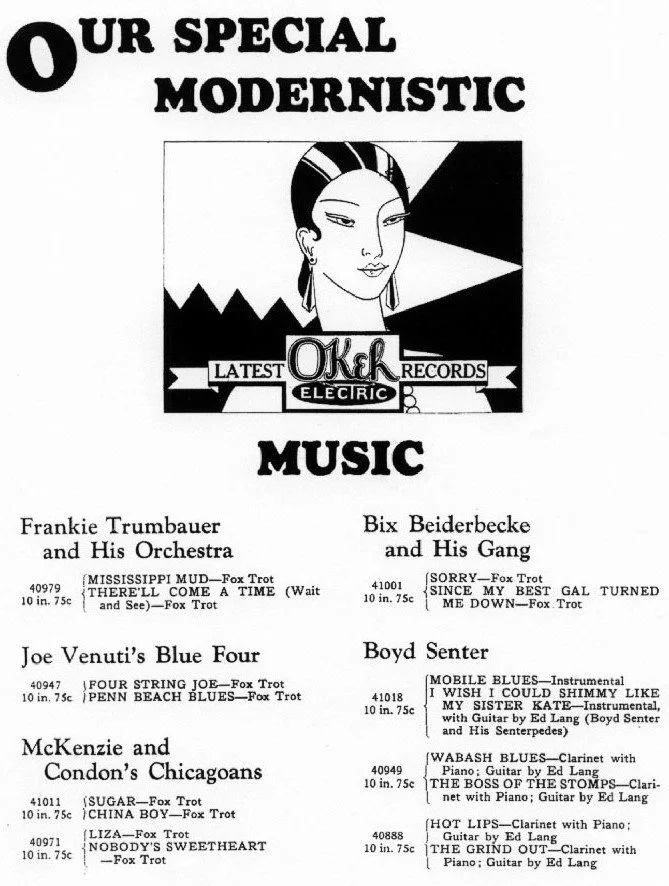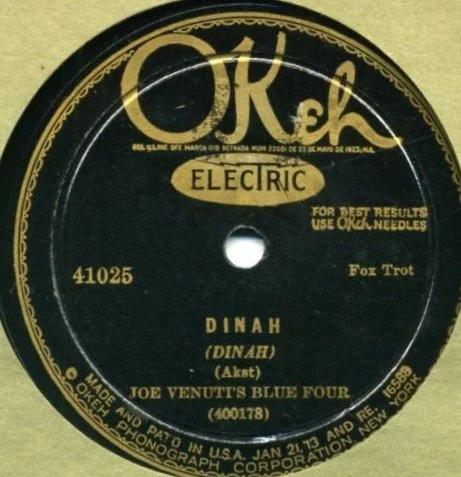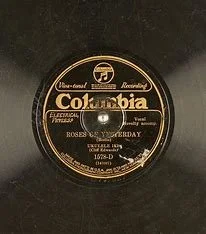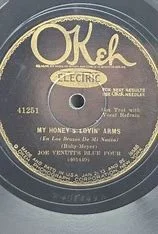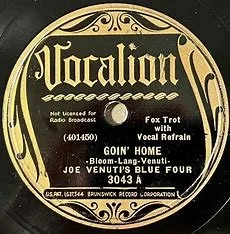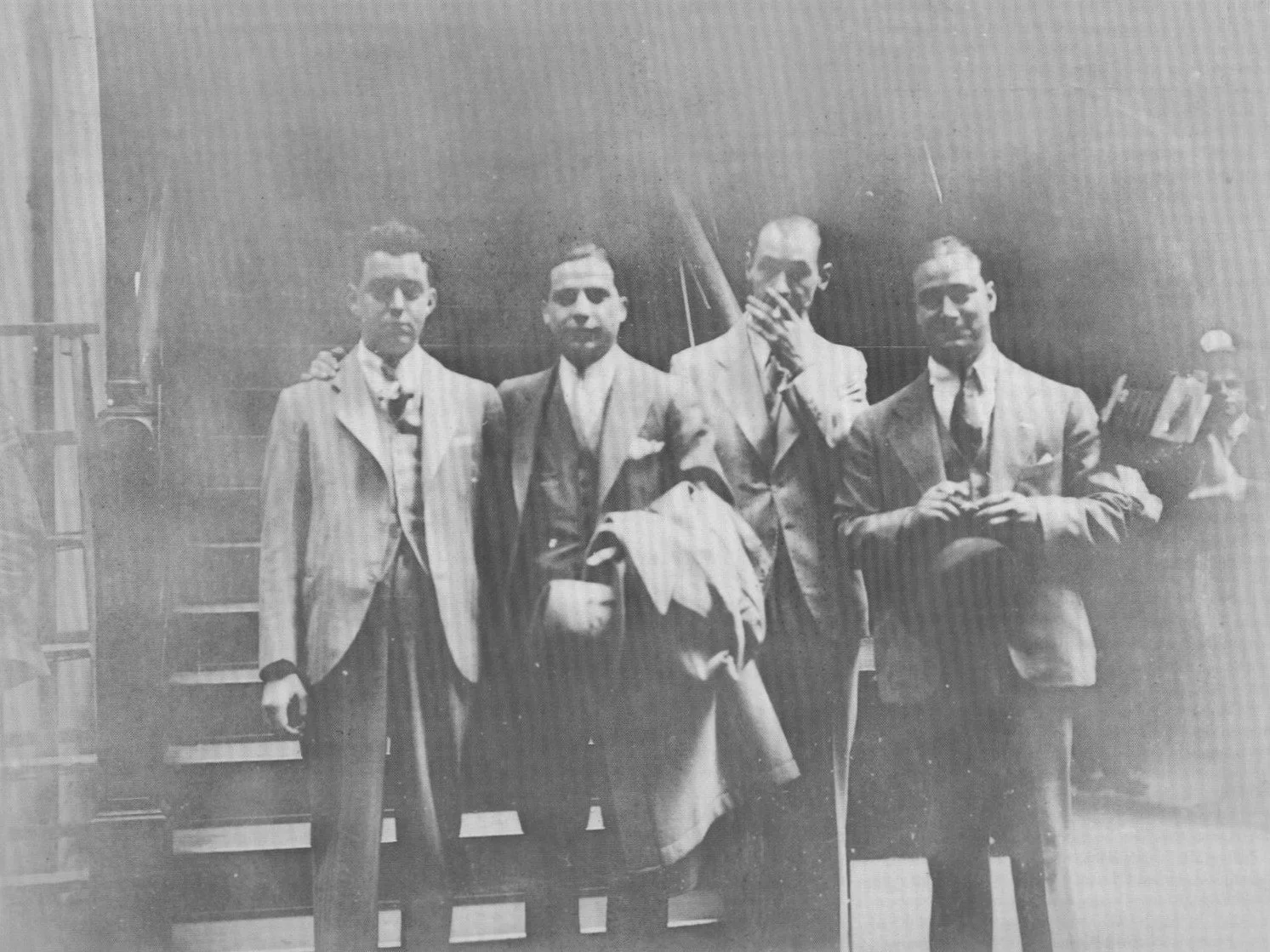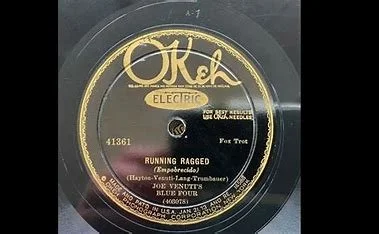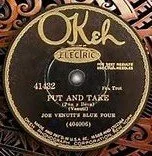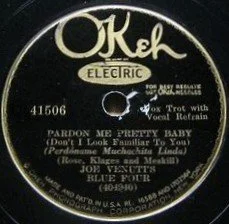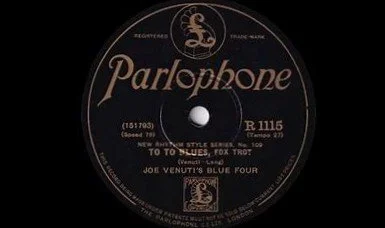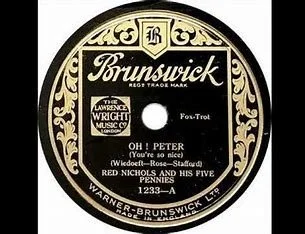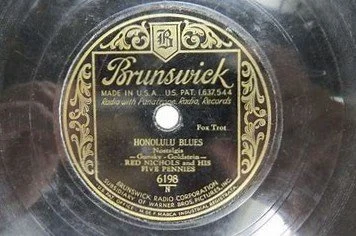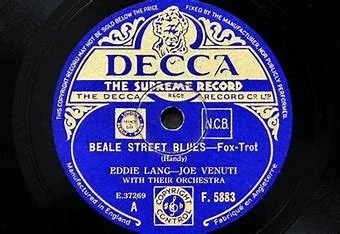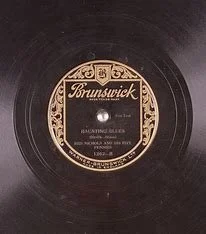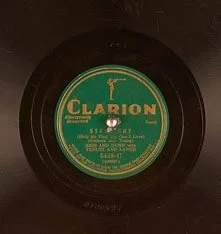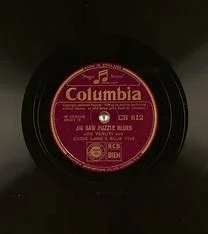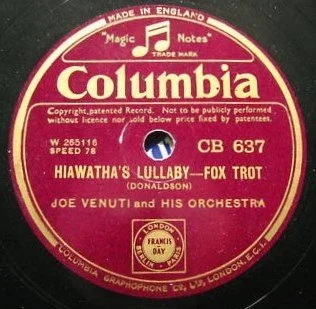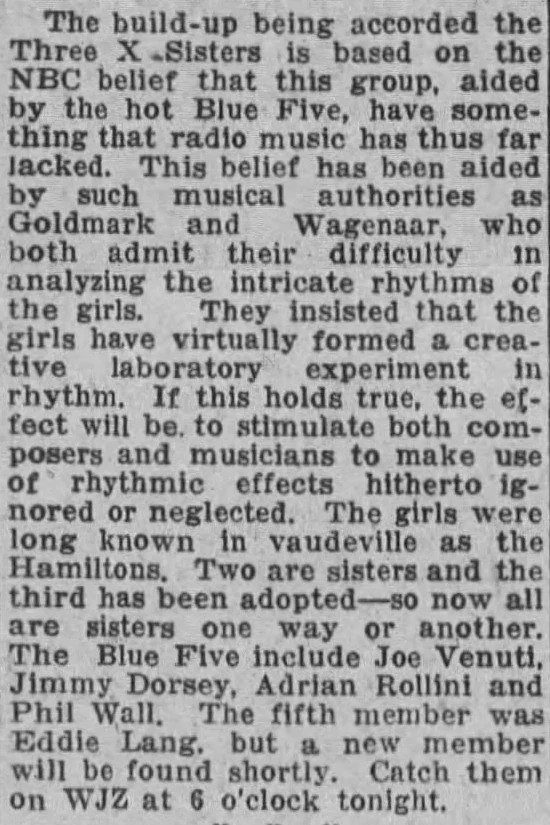THE COMPLETE
JOE VENUTI & EDDIE LANG
SMALL GROUP SESSIONS
September 1926-February 1933
The Complete Joe Venuti and Eddie Lang Small Group Sessions is a compilation of thirty-five recording sessions between September 1926 and February 1933. This anthology features sessions recorded under their names, highlighting the Venuti/Lang duo, trio, Blue Four & Five, and collaborations with other artists for a total of ninety-five sides*. Notably, their appearance in the 1930 film KING OF JAZZ marks the only instance where the duo is captured on film.
This collection is a groundbreaking tribute to the rich tradition of violin and guitar playing, showcasing the pioneering spirit of chamber jazz**. Venuti and Lang's entry into the entertainment industry represented a transformative moment in the musical landscape, introducing an innovative and captivating style that resonated throughout the Jazz Age. Venuti's extraordinary inventiveness and virtuosity, combined with Lang's advanced technical, harmonic, and rhythmic skills as a soloist and accompanist, elevate these recordings, making them exceptional. They stand as powerful testaments to their artistry and the remarkable synergy they shared in creating chamber jazz arrangements. Joe Venuti consistently regarded his recordings with guitarist Eddie Lang as his favorites and the most significant of his illustrious career.
Special thanks go to Mosaic Records for their work on the Venuti/Lang sessions for OKeh and Columbia Records, which Doug Pomeroy expertly restored from many of the original sources. Historian and discographer Steven Lasker also deserves appreciation for contributing to, reviewing, correcting, and updating the sessions, titles, OKeh studio recording locations, and supplying The Phonograph Monthly Review, December 1927, OKeh article. We are grateful to them for their continued support.
* There are a handful of recordings that have yet to be uncovered, primarily those from 1932.
** Red Nichols is also due credit for his pioneering of chamber jazz starting in October 1926.
NOTE: Several placeholder images are used for completeness; they will be replaced when better copies become available.
1926
Thursday, September 16: Joe Venuti turns twenty-three (b. 1903).
Venuti/Lang Small Group Session-1
JOE VENUTI & EDDIE LANG
Joe Venuti (violin), Eddie Lang (guitar).
Wednesday, September 29, 1926
Recording Location: Columbia Studios, 1819 Broadway (at Columbus Circle), in the Gotham National Bank Building, NYC.
W42697-1 Stringing The Blues (Venuti-Lang)-Columbia test pressing
W42697-2 Stringing The Blues (Venuti-Lang)-unissued
W42697-3 Stringing The Blues (Venuti-Lang)-unissued
W42698-2 Black And Blue Bottom (Venuti-Lang)-Col 914-D
STRINGING THE BLUES-Take 1
In their first recording under their names, Joe Venuti and Eddie Lang attempted three takes of STRINGING THE BLUES. Unfortunately, all three takes were rejected, and the master recordings were destroyed. However, a shellac test pressing of Take 1 still exists. Penciled comments on the label read "Reject" and "Weak," likely referring to the signal level rather than the quality of the performance. The rendition is more similar to TIGER RAG than the issued takes, as the duo had been playing their variation of the chords to this warhorse for years. They had just finished leading their band in Atlantic City for the summer season, where they began putting the finishing touches on STRINGING THE BLUES.
BLACK AND BLUE BOTTOM contains little melody for two musicians known for their melodic prowess. Instead, it serves as a showcase for Joe's exceptional skill on the violin, with Eddie providing a pulsating rhythm in the background. The way the violinist effortlessly navigates the harmonic breaks is breathtaking. As the song transitions into the final chorus, Lang fills in with an exceptionally long series of chords (12 bars), allowing Venuti to prepare his bow to showcase his violin playing in a four-string style. This recording marks the first time a violin and guitar have executed an entire jazz piece from start to finish. When musicians and record buyers first heard these sounds, it was groundbreaking.
Venuti/Lang Small Group Session-2
JOE VENUTI & EDDIE LANG
Joe Venuti (violin), Eddie Lang (guitar).
Friday, October 22, 1926
Recording Location: Columbia Studios, 1819 Broadway (at Columbus Circle), in the Gotham National Bank Building, NYC.
W42697-4 Stringing The Blues (Venuti-Lang)-unissued
W42697-5 Stringing The Blues (Venuti-Lang)-unissued
W42697-6 Stringing The Blues (Venuti-Lang)-unissued
W42697-7 Stringing The Blues (Venuti-Lang)-unissued
NOTE: No audio exists from this date, their second duet recording session.
Monday, October 25, 1926: Eddie Lang turns twenty-four (b. 1902)
Venuti/Lang Small Group Session-3
JOE VENUTI & EDDIE LANG
Joe Venuti (violin), Eddie Lang (guitar).
Monday, November 8, 1926
Recording Location: Columbia Studios, 1819 Broadway (at Columbus Circle), in the Gotham National Bank Building, NYC.
W42697-8 Stringing The Blues (Venuti-Lang)-Col 914-D
W42697-9 Stringing The Blues (Venuti-Lang)-unissued
W42697-10 Stringing The Blues (Venuti-Lang)-unissued
W42697-11 Stringing The Blues (Venuti-Lang)-Col 914-D
Columbia scheduled a third recording session for Venuti and Lang to try again to record an acceptable version of STRINGING THE BLUES. Out of the four recordings made, two were considered satisfactory. Despite facing challenges in the previous two sessions, which resulted in seven rejected takes, Joe and Eddie still seemed uncertain about the best tempo for their performance. However, the two successful takes provide insight into their thought process and goals. They achieved their aim with Take 11, which had a slightly faster tempo, capturing the essence of their performance. Listen for their foot tapping during the breaks! These two musicians swung hard, playing with a powerful beat that drove their music forward, regardless of the tempo.
Note: The Columbia Phonograph Corporation purchased the General Phonograph Corporation and its OKeh and Odeon labels effective November 1, 1926.
The Greensboro Record, North Carolina, Tuesday, April 12, 1927
The Post Cresent, Appleton, Wisconsin, Friday, April 15, 1927
Application For Copyright, signed and submitted by Eddie Lang, December 3, 1926.
Their final recording session as a duo brings another pair of Venuti-Lang compositions to light. WILDCAT can undoubtedly be counted among their best performances. Joe and Eddie reworked the song CHINA BOY, varied the chord changes, and added a "B" section, which we'll refer to as “A Venuti.” With Eddie’s assistance, Joe would create these “Venuti” sections and insert them into the middle of a pop song. Although it had nothing to do with the song's original harmonies, it served as a break from the routine chord sequence, delivering a punch every time they transitioned in and out of it. Ingenious! WILDCAT makes an abridged appearance in the 1930 film "The King of Jazz," where the duo can be seen and heard playing live for thirty-five seconds, at a furious pace. (The close-up inserts of Lang and Venuti have the boys playing to a pre-recorded track.) The next time you watch the film, notice the camera-shy Lang having a grand time, while Venuti looks like he's waiting on death row. To impress, they often pulled WILDCAT out during concerts, vaudeville gigs, and parties. Impressed we are!
MAX HARRISON: "In WILD CAT of 1927, their partnership from childhood is evident in the complete integration of violin and guitar. Yet Venuti's line is more overtly "violinistic", the phrases more elaborate than in STRINGING THE BLUES. The standard of musicianship is very high, and the improvising replete with invention, wit, and a sense of purpose that is emphasized by considerable rhythmic acuity. One's main impression, though, is of a sunny melodiousness that is perhaps an echo of the fishing holidays near Atlantic City with which Lang and Venuti used to relieve the intensity of their otherwise year-long musical activities."
SUNSHINE is an instrumental that could easily have become a pop song had lyrics been added. Venuti remains consistent in playing the verse and the beautiful melody, delivering ballads with a moving sense of expression that is very operatic. Lang contributes big, fat chords, alternating his strokes first on the lower half of the chord, then the upper half. This is another technique he devised for his mixed bag of accompaniment styles. Notable is the natural room echo when musicians are placed too far from the microphone in a cavernous studio.
NOTE: SUNSHINE is an Eddie Lang/Red Nichols composition put together three months earlier (November 1926) for a Nichols/Red Heads PATHE record date, calling it GET A LOAD OF THIS. Venuti & Lang recorded it in January 1927 as SUNSHINE. When Eddie recorded the song under his name for OKeh Records in April 1927, it was re-titled EDDIE'S TWISTER. Robbins published it as a Red Nichols trumpet feature titled FUNNY NOTES.
1927
Venuti/Lang Small Group Session-4
JOE VENUTI & EDDIE LANG
Joe Venuti (violin), Eddie Lang (guitar).
Monday, January 24, 1927
Recording Location: OKeh Studios, 145 West 45th Street, NYC.
W80328-A Wild Cat (Venuti-Lang)-OK 40762
W80329 Sunshine (warm-up)-Mosaic Box Set (1)
W80329-A Sunshine (Venuti-Lang)-OK 40762
The Phonography & Talking Machine Weekly, April 1927.
Venuti/Lang Small Group Session-5
JOE VENUTI & EDDIE LANG
Joe Venuti (violin), Eddie Lang (guitar), Arthur Schutt (piano).
Wednesday, May 4, 1927
Recording Location: OKeh Studios, 145 West 45th Street, NYC.
W81058-B Doin’ Things (Venuti-Lang)-OK 40825
W81059-B Goin’ Places (Venuti-Lang)-OK 40825
Two classic compositions by Venuti and Lang receive equally classic interpretations. The duo, now expanded to a trio, is joined by pianist Arthur Schutt, affectionately known as the "Baron." A veteran of the Roger Wolfe Kahn band, where all three musicians were current members, Schutt was an exceptional piano player and a creative arranger. His nickname was inspired by his tailored wardrobe and the ever-present flower in his lapel.
With Schutt's presence, Eddie can modify his role; he now gives the piano the duties he previously held—laying the harmonic foundation and establishing a solid rhythm. This change allows Lang to provide counter-line accompaniment akin to his outstanding contributions to the Trumbauer/Beiderbecke recording of SINGIN’ THE BLUES, he can also take single-string solos. Additionally, Joe and Eddie pay homage to impressionist music maestro Claude Debussy in their piece DOIN’ THINGS, borrowing the opening phrase from "La Fille aux Cheveux de Lin."
“GOIN’ PLACES" showcases Venuti's talent as a tour de force. Even at the high velocity of the performance, his playing exudes sensibility. This instrumental is filled with violin and guitar breaks, with the standout moments being those that the duo shares and Eddie's impressive picking on a diminished chord. With the piano serving as a foundation, Lang's new role in the trio allows him to introduce harmonic and rhythmic colors that enrich the performance.
During this time, studio engineers often placed the piano far from the microphone, hoping to control its large sound and prevent it from dominating the recording. This practice did not achieve its intended goals, resulting in an interesting mix. As a result, Venuti and Lang, positioned closer to the microphone, seem to float above the harmonic backdrop created by the distant keyboard.
Sunday, July 3, 1927- The Plain Dealer, Cleveland, Ohio.
Sunday, October 9, 1927 - The Plain Dealer, Cleveland, Ohio.
Venuti/Lang Small Group Session-6
RED McKENZIE AND HIS MUSIC BOX
Red McKenzie (comb, vocal), Joe Venuti (violin), Eddie Lang (guitar), poss. Jack Bland (banjo).
Tuesday, June 21, 1927
Recording Location: OKeh Studios, 145 West 45th Street, NYC.
W81037-B There’ll Be Some Changes Made (Overstreet)-OK 40893
W81038-C My Syncopated Melody Man (Merriel-Cox)-OK 40893
On THERE’LL BE SOME CHANGES MADE, we hear Eddie’s agile rhythm style as he adds his own harmonies to the original chord structure (i.e., the diminished chord in the second measure). McKenzie hums the lead through his comb-and-paper, sounding not unlike a muted trumpet, while Venuti embellishes. I hear a banjo in the mix, off-mike. My guess is that it’s a plectrum banjo, probably played by Jack Bland. Venuti and McKenzie share solo honors while the rhythm instruments swing like mad.
MY SYNCOPATED MELODY MAN finds a groove and stays with it. Working with his pal Joe and with Red seems to act as a tonic on Eddie as he punctuates Joe’s chorus (surely one of the earliest pizzicato solos in jazz) with scampering triplet fills. (Marty Grosz, 2002)
Venuti/Lang Small Group Session-7
FOUR INSTRUMENTAL STARS (1)
ANNETTE HANSHAW (2)
Joe Venuti (violin), Eddie Lang (guitar), Rube Bloom (piano-1), unknown (piano-2), Adrian Rollini (bass sax, celeste, goofus, hot fountain pen), Vic Berton (drums, chimes), Annette Hanshaw (vocal all titles).
Friday/Saturday, ca. June 24/25, 1927
Recording Location: Pathe Studios, 150 E. 53rd St., NYC.
107645-2 I’m Somebody’s Somebody Now (Silver-Johnson-Sherman)-PA 36664 (1)
107646-1 I Like What You Like (Rollini-Keane-Rodgers)-PA 36664 (1)
107647-1 Ain’t That A Grand A Glorious Feeling (Yellen-Ager)-PA 32275 (2)
107648-? Who-oo? You-oo, That’s Who! (Yellen-Ager)-PA 11540 (2)
107650-2 Under The Moon (Lyn-Wheeler-Synder)-PA 32275 (2)
On I’M SOMEBODY’S SOMEBODY NOW, a rousing bass sax break launches Venuti’s fiddle, backed by vigorous strumming from Lang. Through the years, critics and players have faulted Lang’s four-four rhythm playing, myself among them, and I can’t think why. His chords are full and rich, and his beat swings right down the middle of the time. And who would have thought that tympani could work in a four-piece combo? But they do: Berton’s half chorus is a hoot!
I LIKE WHAT YOU LIKE has Joe playing the verse and chorus, then Rollini pulls a masterful modulation out of his bag of tricks, seamlessly leading into the new key for the vocal. The piano verse is almost likely performed by Rollini as well. He had been something of a child piano prodigy, even having cut professional piano rolls as a teenager. In the mid-30s, he would become a full-fledged vibraphonist.
AIN’T THAT A GRAND AND GLORIOUS FEELING has Joe and Eddie initiating the proceedings in harmony, then we hear a bell-like instrument, perhaps the harpophone, attributed to Vic Berton and Rollini’s hot fountain pen which resembles a hillbilly clarinet, after which the group finds its stride and never loses it. Decide what sort of a compliment is implied in the phrase “who loves like Lindberg flies?”
Any other bass saxophonist would have overshadowed Hanshaw’s first vocal chorus; it’s an instrument whose deep “harumph” can dominate a situation. On UNDER THE MOON, for example, Rollini’s control is superb. In his hands, the weighty bass sax scampers like an alto sax. Hanshaw, feeling her oats, intersperses her vocal with excursions into a high falsetto register, a mannerism that was a trademark of comedic country singers like “Aunt” Minnie Pearl. Who’s responsible for the two-bar piano break? My guess is that it’s Hanshaw who could play a little. Lang comes up with a ritardando that ushers in a slower tempo. Hanshaw almost enters three beats too soon but recovers as Eddie guides her. What follows is a graceful, almost poignant guitar obligato with just a springling of celeste (Rollini?) – a unique ethereal sound. (Marty Grosz 2002)
Venuti/Lang Small Group Session-8
JOE VENUTI’S BLUE FOUR
Joe Venuti (violin), Eddie Lang (guitar), Arthur Schutt (piano), Adrian Rollini (bass sax, goofus, hot fountain pen).
Tuesday, June 28, 1927
Recording Location: OKeh Studios, 145 West 45th Street, NYC.
W81118-B Kickin’ The Cat (Venuti-Lang)-OK 40853
W81119-C Beatin’ The Dog (Venuti-Lang)-OK 40853
A new addition to the Venuti-Lang trio is Adrian Rollini, who brings his bass saxophone, goofus, and hot fountain pen to the team. At this point, Venuti and Lang had developed an adequate instrumentation to implement a musical formula they had been experimenting with for some time. For the past four years, Joe and Eddie had been co-leading small groups in nightclubs and social events. In addition to the violin and guitar (and banjo), their ensemble typically included a couple of horns and a rhythm section. The music was performed exclusively for dancing; no written charts were used, as they relied on head arrangements, and their repertoire consisted of pop songs and, as needed, some ethnic tunes.
At OKeh, Joe and Eddie were given the opportunity to record their music and play jazz. Notably, the "BLUE" groups they led on records never existed outside the recording studio (see the intriguing May/April 1933 newspaper clipping at the close of this piece). With this first group session, Joe and Eddie unveiled a musical vision for their chamber jazz ensemble. They tackled jazz and pop songs, along with an original repertoire arranged in unique and creative ways to ensure the music could swing. Clever introductions, outros, interludes, new harmonies, key changes, and breaks (both solo and shared), combined with a variety of instruments, enhanced performances that appeared to be in a constant state of forward motion.
By the 1930s, each of their records incorporated elements of pop music (a thread of the melody runs through the recording), jazz (with improvised solos), and novelty (including pizzicato, four-string violin, and toy instruments), all sprinkled with humor and shaded with diverse colors, textures, and rhythms.
The instrumentation of this little band was distinctive. When they expanded to a trio by adding a piano (with Eddie demonstrating his mastery of working with the keyboard), the addition of a bass instrument became logical (a tuba was deemed unsuitable as it didn't blend well with strings). They considered incorporating an upright bass but ultimately opted for a saxophone (either bass or baritone). This choice provided the ensemble with a strong foundation while adding another voice to the front line that could engage in musical dialogue with Venuti's violin.
The introduction of the piano altered Eddie's role, just as the saxophone changed Venuti's. Joe welcomed this addition. Sharing the front line with Rollini, Murray, and Dorsey inspired the violinist's solo, ensemble, and arranging talents. The saxophone seamlessly wove in and out of the ensemble, transitioning from the bass chair to the front line and back, utilizing the full range and qualities of the instrument. Regarding the musical arrangements, Joe and Eddie would often sketch out their ideas the night before, and at the next session, everyone would contribute to shaping the arrangement.
With such exceptional talent, the Joe Venuti Blue Four (and subsequent Blue Five) sessions introduced jazz's first wind and string ensemble. Lang sets the tone on KICKIN' THE CAT with a jangling six-bar chord introduction, while Rollini's Goofus picks up in bars seven and eight. Venuti leads with support from the Goofus on another harmony-based original that lacks a melody yet is predominantly defined by Eddie's guitar (with its extra-thick bass string), which lays down the chord progression. Joe and Eddie also incorporate elements of early classical salon music in the interlude.
BEATIN' THE DOG is another jam tune in the style of "Jazz Me Blues" and "Original Dixieland One-Step." Rollini plays his bass sax for the entire piece, showcasing his brilliant counterline and fills, which consistently elevate the ensemble. His bass sax solo stands up to any created by Beiderbecke or Armstrong during that era. Rollini, a child prodigy on piano, could play virtually any instrument in a dance band and was adept at making toys “sing,” as he did with the Goofus and the hot fountain pen.
Venuti/Lang Small Group Session-9
ANNETTE HANSHAW ACC. BY HER SIZZLIN’ SYNCOPATORS
Joe Venuti (violin), Eddie Lang (guitar), unknown (piano-107765), Adrian Rollini (bass sax, hot fountain pen), Vic Berton (drums), Annette Hanshaw (vocal all titles).
ca. Thursday, September 8, 1927
Recording Location: Pathe Studios, 150 E. 53rd St., NYC.
107765 It Was Only A Sun Shower (Kahal-Wheeler-Synder)-PA 32293
107766 Who’s That Knocking At My Door (Kahn-Simmons)-PA 32293
IT WAS ONLY A SUNSHOWER sounds like Joe is playing the melody off a lead sheet while Eddie is weaving one of his extemporaneous accompaniments. Songwriters, noticeably jealous of their efforts, must have been pleased to have them performed by the likes of Venuti and Lang, or were they? The fact is that Eddie’s lonely lines are often more interesting than the song or the singer.
With WHO’S THAT KNOCKING AT MY DOOR? we get a smattering of single-string guitar melody backed by sustained violin tones. Fans of Rollini’s hot fountain pen are treated to 16 measures. In 1929, Hanshaw answered a knock from the Pathe recording manager, whom she married. Her recording career lasted until 1934. (Marty Grosz, 2002)
Venuti/Lang Small Group Session-10
JOE VENUTI’S BLUE FOUR
Joe Venuti (violin), Eddie Lang (guitar), Rube Bloom (piano), Adrian Rollini (bass sax, goofus, hot fountain pen).
Tuesday, September 13, 1927
Recording Location: OKeh Studios, 11 Union Square West, NYC.
W81432-C Cheese And Crackers (Venuti-Lang)-OK40897
W81433-C A Mug Of Ale (Venuti-Lang)-OK 40897
Refreshed after spending part of the summer in Atlantic City with the Jean Goldkette Orchestra, the boys returned to New York near the end of August. The big news around town was the formation of the New Yorkers, Adrian Rollini's dream band made up of former members of the Jean Goldkette Orchestra, the cream of New York's studio players, and the Big Apple’s "hot” men. Nightclubs were opening and closing at a ferocious rate in those days; all had ties to organized crime, which used the facilities to launder money and play out other nefarious underworld deeds. Club New Yorker was one such location. It was out of business within weeks of opening.
On Tuesday, September 13th, hopes were still high for the new club and its prestigious orchestra. This Venuti-Lang recording session took place in the morning as they were to head over to 48th and Broadway for an afternoon rehearsal with the Rollini band at the ill-fated Club New Yorker. CHEESE AND CRACKERS is one of their prettiest melodies. It is a well-written and orchestrated piece of music. (It was treated to a big band arrangement in 1933 and recorded by Venuti in September for Banner.) The highlight of this quartet interpretation is that Rollini plays in the upper register, and Venuti plays chords behind Lang's single-string solo. CHEESE AND CRACKERS would have made a terrific guitar solo (with piano accompaniment) had Lang decided to record it. Besides Eddie's idea for an intro, which they also use as an interlude and a close, A MUG OF ALE is a straight-ahead reading on the harmonies of LIMEHOUSE BLUES. It provides everyone solo space (which Rollini devours). Just as things were beginning to heat up, they ran out of time. This one deserved another chorus.
Venuti recalled years later that after sessions such as this one, he and Eddie would grab a cab at Union Square and dash downtown to Broome Street in Manhattan's Little Italy. There, they'd sit for an afternoon of "spags and vino" at the Grotta Azzurra. When Joe and Eddie were customers in 1927, Grandpa Davino ran the place and prepared the food with his wife. Fifty years later, Joe ate at the restaurant, now run by John Davino, the family's grandson. On one occasion they snuck the maestro into the kitchen to give the dishwasher “the bird,” scaring the crap out of him. The entire restaurant roared with laughter. What a life!
The Phonograph Monthly Review, December 1927
Friday, September 16, 1927: Joe Venuti turns twenty-four (b. 1903)
Tuesday, October 25, 1927: Eddie Lang turns twenty-five (b. 1902)
Venuti/Lang Small Group Session-11
JOE VENUTI’S BLUE FOUR
Joe Venuti (violin), Eddie Lang (guitar), Frank Signorelli (piano), Don Murray (baritone sax, clarinet), poss. Justin Ring (cymbal).
Tuesday, November 15, 1927
Recording Location: OKeh Studios, 11 Union Square West, NYC.
W81822-B Penn Beach Blues (Venuti-Lang)-OK 40947
W81823-C Four String Joe (Venuti-Lang)-OK 40947
During the summer, when Venuti and his crew arrived in Atlantic City, they settled into one of the many family-run guest houses along Pennsylvania Avenue. The avenues, named after states, ran east towards the water, and it was a short walk to the boardwalk and the beach. Joe preferred to carve out his own little spot on the sand near the intersection of Pennsylvania Avenue and the water. Venuti eventually honored this location in a song for a specific date, which also brought two old friends into the mix: saxophonist Don Murray, whom Joe first met in 1924 while working with Goldkette in Detroit, and Frank "Cheech" Signorelli, a pianist they had known since their early visits to Manhattan in the first years of the decade. Murray blended perfectly on baritone and clarinet, as did Signorelli, although the violinist considered him a "Dixieland player," presumably not in Arthur Schutt's league (few were). Nonetheless, this second BLUE team was a strong combination and well equipped to handle the two new pieces prepared for the session. All four musicians were incredibly inventive individually and had the talent to create mini arrangements spontaneously, which they often did for many of the small group recording sessions they participated in. For PENN BEACH BLUES, Eddie's idea for the introduction had everyone crafting their parts around the guitarist's riff: Murray came up with an ascending bass line, Venuti mirrored the guitar with double stops, and Signorelli added some spicy touches on the piano.
Joe Venuti was an aggressive player known for producing a big sound from the instrument, characterized by a heavenly tone and "swinging" operatic phrasing. From his first recorded violin solo in 1924 with Jean Goldkette, Joe had been expertly manipulating his bow for most of the twenties. Venuti never limited himself to focusing solely on single (or double) string playing. As a guitarist and pianist, he also used the violin as a rhythm instrument. The driving force behind his playing was a strong beat, which he applied every time he put bow to string. When he switched to four strings, Venuti expanded his improvisational options, adding another dimension to his playing. He could assume the role of an accompanist, allowing each band to instantly benefit from his ability to create a string quartet. In FOUR STRING JOE, the band embraces a lively, energetic style typical of country music, even though they were city dwellers. Venuti utilizes the four strings almost exclusively until the last chorus, sawing at the violin and playing chords while delivering rhythmic phrases. In an inspiring moment, he and Murray (on baritone) liven things up during the violinist's second solo chorus. Eddie's single-string chorus features two bars of impressive picking, followed by another two measures filled with funky bends in the lower register.
The Talking Machine World, April 1928.
1928
Venuti/Lang Small Group Session-12
JOE VENUTI’S BLUE FOUR
Joe Venuti (violin), Eddie Lang (guitar), Rube Bloom (piano), Don Murray (baritone sax), poss. Justin Ring (cymbal, chimes).
Wednesday, March 28, 1928
Recording Location: OKeh Studios, 11 Union Square West, NYC.
W400178-A Dinah (Lewis-Young-Akst)-OK 41025
W400179-A The Wild Dog (Venuti-Lang)-OK 41025
W400179-C The Wild Dog (Venuti-Lang)-OKeh test pressing
Up until this point, Joe and Eddie had exclusively recorded original material for OKeh. This session marks their first cover of a popular tune; from this point onward, all Venuti-Lang recordings (with one exception) will include at least one pop song. Both sides of OKeh 41025 benefit from being recorded in a small studio, which may have aided the engineers in achieving the best recording balance to date. Murray’s baritone sax, played brilliantly during this session, resonantly booms on both tracks. During the first chorus of DINAH, his playing sounds almost like an arco bass, with a legato that is exceptionally smooth. The relaxed tempo allows the quartet to interact extensively, which they do with great sensitivity. This is a testament to their superior musicianship, and it’s unfortunate that this caliber of jazz musician has become less recognized.
Everyone gets a chance to shine on DINAH, while still adhering closely to the melody. Murray and Venuti share a poignant interpretation of the bridge, and Lang provides solid rhythmic support during his solo. The only real intensity in the piece comes in the last six bars, but even that is brief as Venuti's harmonics soar like a bird over the coda. It appears that someone (possibly Justin Ring) strikes the final note by tapping the studio bells at the very end, and he can also be heard briefly playing the choke cymbal during the last six bars of the song. In his later years, the violinist wished to return as a bird "because they’re so free," and recordings like this make a strong case that he might have fulfilled that promise while still living.
THE WILD DOG is a creation of Venuti and serves as his tour de force. When he settles into the A section and fully exploits the fourth bar after the piano’s initial sixteen bars, it sends chills up the spine. Although Lang and Murray each take a solo, Venuti maintains the lead through the various sections, demonstrating his complete command of the bow and dazzling technique. This performance is a masterful display by the violinist and stands as one of the milestone Venuti-Lang recordings.
The test pressing of "THE WILD DOG" (unissued Take C) allows us to compare and appreciate the variations the quartet offers when given another opportunity to interpret the same piece of music. Notably, in Take C, the piano is off-mic at the beginning (0:04-0:07), followed by the violinist missing his cue and being mixed low (0:17-0:24). Are two microphones being used, and the engineers are fiddling with the levels? (see engineer Doug Pomeroy’s comment in the December 12, 1928, session). Regardless, this is a stunning performance by the quartet.
Venuti/Lang Small Group Session-13
RED McKENZIE AND HIS MUSIC BOX
Red McKenzie (comb, vocal), Joe Venuti (violin), Eddie Lang (guitar), Eddie Condon (banjo).
Tuesday, May 29, 1928
Recording Location: OKeh Studios, 11 Union Square West, NYC.
W400720-A My Baby Came Home (Fields-Newman-Gardner)-OK 41071
W400721-B From Monday On (Barris-Crosby)-OK 41071
W400721-C From Monday On (unissued) (Barris-Crosby)-Jazz Oracle BDW 8047
On MY BABY CAME HOME and FROM MONDAY ON, Lang and Condon are relegated to playing rhythm, but how well they do it. Lang lays down a four-four beat, interjecting bass notes now and then. Condon, imitating a drummer, picks up-stroke accents at crucial points.
Notice how skillfully Venuti fills behind McKenzie’s statement of melody. As Joe launches into his solo, Condon supports him with a shuffle rhythm. It’s apparent that the collaboration of New York and Chicago styles will prove to be a winner.
On MY BABY CAME HOME, McKenzie gets to the microphone and shows how it’s done, although he consistently sings “come” instead of “came.” Venuti follows with a rococo violin statement over a rolling shuffle. Then comb and violin polish off this delightful bagatelle from the Roaring Twenties. (Marty Grosz, 2002)
FROM MONDAY ON commences with a pleasant guitar-and-violin vamp that is broken in upon by the four bars of hysterical skat singing, no doubt from the lips of Eddie Condon, who, in his youth, fancied himself something of a vocalist. He soon disabused of his delusion and, in later years, would shudder and slink away when someone played a record of his early singing efforts. (Marty Grosz, 2002)
Fans of Red McKenzie will be pleased to hear the newly-discovered take of FROM MONDAY ON by McKenzie’s Music Box, a band featuring Joe Venuti, Eddie Lang, and Eddie Condon. Take B of this title was issued on the original OKeh release; no other genuine alternative takes have been discovered, despite the release several years ago of a Columbia LP claiming to include Take A. The take presented here (Take C) is significantly different from the issued one, both in the instrumental parts and in McKenzie’s exhortations to Joe Venuti during his solo. (Gift From The President, Jazz Oracle BDW 8047, 2005)
Venuti/Lang Small Group Session-14
JOE VENUTI’S BLUE FOUR
Joe Venuti (violin), Eddie Lang (guitar), Rube Bloom (piano, RB vocal), Don Murray (baritone sax), Paul Graselli or Justin Ring (drums).
Thursday, June 14, 1928
Recording Location: OKeh Studios, 11 Union Square West, NYC.
W400788-C The Man From The South (Bloom-Woods)-OK 41076 (RB-vocal)
W400789-B Pretty Trix (Venuti-Lang)-OK 41076
Here's a great example of what creative artists can accomplish with minimal resources. Venuti & Co. take a swipe at a new Rube Bloom composition, THE MAN FROM THE SOUTH, transforming a simple minor theme into a lively performance. This piece is one of the earliest instances where Venuti and Lang chose to limit the arrangement and focus instead on delivering one energetic chorus after another, which they achieve with infectious enthusiasm and a compelling beat. From the emotional introduction played by the violinist to the interplay between Murray and Venuti, and through Lang's solo (which he shares with the baritone), Bloom's engaging work provides an excellent backdrop for improvisation. Over the course of nine choruses, every musician gets a chance to solo, and Bloom even leaps from the keyboard not once, but twice, to deliver his unique vocals. "Play It, Son!"
Bloom, a skilled pianist and composer, would go on to contribute the music to several classic songs in the American Popular Songbook, including "Day In, Day Out" (lyrics by Johnny Mercer), "Don't Worry 'Bout Me" (lyrics by Ted Koehler), "Fools Rush In (Where Angels Fear to Tread)" (lyrics by Johnny Mercer), and "Give Me the Simple Life" (lyrics by Harry Ruby).
PRETTY TRIX is a piece that Venuti adapted from a bowing exercise. From this foundation, he and Eddie crafted a dreamy composition featuring a catchy three-quarter rhythm. Bloom, whose first name Rube is pronounced "Ruby," takes center stage during the song's interlude, delivering it in a charming, period style. When Eddie plays Venuti's melody, he showcases his skill with some intricate picking techniques to navigate the challenging triplets, which are more suited for a bow than a pick.
Los Angeles Evening Post Record, California, Monday, August 27, 1928.
Venuti/Lang Small Group Session-15
JOE VENUTI & EDDIE LANG
Joe Venuti (violin), Eddie Lang (guitar), Frank Signorelli (piano).
Thursday, June 21, 1928, 10:00 am-12:00 pm
Recording Location: Victor Studios, NYC TBD.
BVE45812-1 Doin’ Things (Venuti-Lang)-“X” LVA-3036 (LP)
BVE45812-2 Doin’ Things (Venuti-Lang)-BB B-10280
BVE45812-3 Doin’ Things (Venuti-Lang)-Vic 21561
BVE45813-1 Wild Cat (Venuti-Lang)-BB B-10280
BVE45813-2 Wild Cat (Venuti-Lang)-“X” LVA-3036 (LP)
BVE45813-3 Wild Cat (Venuti, Lang)-Vic 21561
Wednesday, October 10, 1928 - The Idaho Stateman, Boise, Idaho.
Sunday, September 2, 1928 - The Plain Dealer, Cleveland, Ohio.
Sunday, September 16: Joe Venuti turns twenty-five (b. 1903)
Venuti/Lang Small Group Session-16
CLIFF EDWARDS AND HIS HOT COMBINATION
Cliff Edwards (vocal, ukulele), Andy Sanella (alto sax, cello), Joe Venuti (violin), unknown (piano), Eddie Lang (guitar).
Friday, September 21, 1928
Recording Location: Columbia Studios, 1819 Broadway (at Columbus Circle), in the Gotham National Bank Building, NYC.
W147027-5 Roses Of Yesterday (Berlin)-Col 1578-D
W147028-3 Good Little Bad Little You (Green-Stept)-Col 1705-D
W147029-2 Just A Night For Meditation (Lewis-Young-Pollack)-Col 1609-D
These “hot” studio musicians cooked up GOOD LITTLE BAD LITTLE YOU on the spot. Notice how Lang plays straight time until his gem of a break and then starts embellishing Edward’s rendition of the verse. At the chorus, we can hear snippets of strumming by Edwards as someone joins in on string bass; could it be Sanella?
Venuti can be heard making pizzicato comments behind Edwards' kazoo-like trumpet imitation. And who else but Eddie would have thought of those pinging harmonies on the out chorus? (Marty Grosz, 2002)
Venuti/Lang Small Group Session-17
JOE VENUTI’S BLUE FOUR
Joe Venuti (violin), Eddie Lang (guitar), Rube Bloom (piano, RB vocal), Jimmy Dorsey (baritone sax, clarinet), Paul Graselli (drums).
Thursday, September 27, 1928
Recording Location: OKeh Studios, 11 Union Square West, NYC.
W401159-A The Blue Room (Rodgers-Hart)-OK 41144 (RB-vocal)
W401160-A Sensation (Edwards)-OK 41144 (RB-vocal)
A triple session (of sorts) with Venuti's Blue Four sandwiched between two Lang guitar features. Eddie made his way to the studio a few hours early to record a guitar solo that OKeh intended to couple with ADD A LITTLE WIGGLE, which he had previously recorded in March. Eddie chose a pretty waltz, JEANNINE I DREAM OF LILAC TIME, from "Lilac Time," a 1928 First National Picture. Lang had been taking traditional and popular songs and giving them a solo guitar treatment since he was a kid in South Philadelphia. His ability to do so was another facet of his extraordinary gifts as a guitarist. Eddie's interpretations ranged from a straight reading of the theme to reworking the piece with various embellishments. JEANNINE falls within the former as the guitarist delivers a plaintive reading of the verse and two choruses of the melody. This is the kind of stuff OKeh would market to the parents of America's jazz-crazy kids.
The 1926 Rodgers and Hart stage production of The Girl Friend brought THE BLUE ROOM to everyone's attention. Richard Rodgers was not a big fan of people messing around with his music. He benefited from all the interpretations, but when performers took artistic license, it brought out the Russian in him. Lord knows what he thought of Bennie Moten's frantic 1932 rendition of THE BLUE ROOM. Jimmy Dorsey makes his first appearance with the Venuti-Lang combination, and as you'd expect, he's a perfect fit. The eldest Dorsey brings an arsenal of instruments that he plays superbly. A master of the reeds (and an outstanding cornet player), Jimmy was the first exceptional jazz alto sax player and, as a student of clarinetists Jimmie Noone and Johnny Dodds, developed a distinctive clarinet sound that can be heard, along with his alto sax, on countless recording sessions in the twenties. Venuti, Dorsey, and Lang remain faithful to Rodgers, but Bloom gets carried away and massacres the bridge. A highlight, as you will come to hear on this and future Venuti-Lang sessions, is the interplay between Venuti and Dorsey. They generally save it for the grand finale, which is no exception. The violin and clarinet stir things up in the song's final release.
The introduction to SENSATION is disarming but only a momentary lapse as the band rips through this killer-diller. Lang is particularly effective as the engineer situated the guitarist close to the microphone to cover for Bloom during the pianist's absence from the keyboard. (Bloom needed to get up from the piano bench and walk to the single microphone when singing.) Once again, Joe and Jimmy doodle away behind the second vocal chorus, raising the temperature. This is the first time drums have been added to the group. Until now, all other percussive efforts were limited to a choke cymbal. Unfortunately, it sounds as if someone's trying to escape from a large empty cardboard box in the rear of the recording studio. If there's anything good to say about the addition of the drums, it's that they keep a steady rhythm.
Thursday, October 25, 1928: Eddie Lang turns twenty-six (b. 1902)
Venuti/Lang Small Group Session-18
JOE VENUTI’S BLUE FOUR
Joe Venuti (violin), Eddie Lang (guitar), Rube Bloom (piano, RB vocal), Jimmy Dorsey (baritone sax, clarinet, cornet), Paul Graselli (drums), poss. Justin Ring (cymbal).
Wednesday, December 12, 1928
Recording Location: OKeh Studios, 11 Union Square West, NYC.
W401449-A My Honey’s Lovin’ Arms (Meyer-Ruby)-OK 41251 (RB-vocal)
W401450-A Goin’ Home (Bloom-Lang-Venuti)-OK 41251 (RB-vocal)
MY HONEY’S LOVIN’ ARMS receives the Blue Four treatment, with Venuti leading on the melody and Dorsey providing rich tones on the baritone saxophone. Jimmy and Joe alternate on the verse, and Dorsey briefly switches to clarinet as they accompany Bloom’s vocals. Audio engineer Doug Pomeroy made an interesting observation during the restoration of the recording: the piano continues to play during the vocals.
Typically, band members were positioned near a single microphone, as 1920s recording sessions relied on just one mic, with the piano placed away to minimize its pickup. However, it seems the engineers decided to experiment with a two-microphone setup for this session. In the past, Bloom would step away from the piano just before singing, moving to the microphone to deliver his vocals, but this time, a microphone was positioned close to the piano, slightly to the side, allowing Bloom to stay at the piano and lean towards the mic for his performance.
Pomeroy noted that this is one of the extremely rare instances of "gain-riding" by recording engineers on early 78 RPM records. You can hear the difference during the last two bars of Dorsey’s cornet solo, where the microphone appears to have been moved. It’s possible that Bloom himself adjusted the position of the mic, as the piano stops playing during those two bars and then returns quite loudly.
Recording techniques have evolved since those early days, though not always for the better. Towards the end of the song, Eddie plays through what was supposed to be a four-bar break for the baritone solo, quickly repeating his mistake to make it sound intentional. Lang was quick on his feet.
GOIN’ HOME is a jam piece written and arranged in the studio by the band, although only Rube Bloom, Lang, and Venuti receive composer credit and the associated royalties. This is quite a departure from his later famed compositions like "Don’t Worry 'Bout Me" and "Fools Rush In." Bloom retains much of the “ha-cha” spirit of the era, improvising lyrics and scatting through this lively number. Listen for Dorsey’s fiery return to the baritone saxophone after the vocals.
Percussion was never an integral part of the Venuti-Lang recording lineup. When used, it was typically discreet and limited to a choke cymbal, except for the more bombastic session on September 27. The identities of the drummers who worked with Venuti and Lang have always been uncertain. Justin Ring, Paul Graselli, and Stan King have been suggested as possible candidates. Venuti recalled using either Stan King or his understudy, Charlie Kegley, who was a character known among musicians as “Andy Gump” due to his habit of removing his false teeth when drunk. He might have been an entertaining figure to have around, but perhaps not the best choice for a recording session. Unfortunately, all available files offer no insight into who the percussionists were, leaving their identities unknown.
1929
VENUTI, LANG, SCHUTT
THE PROPHYLACTIC PLAYBOYS!
Tuesday, March 12, 1929, Radio Broadcast
Tuesday, March 12, 1929 - Omaha World Herald, Omaha, Nebraska.
Tuesday, March 12, 1929 - St. Louis Post-Dispatch, Missouri.
Tuesday, March 12, 1929 - St. Louis Post-Dispatch, Missouri.
Tuesday, March 12, 1929 - The Pittsburgh Press, Pennsylvania.
Monday, September 16, 1929: Joe Venuti turns twenty-six (b. 1903)
Venuti/Lang Small Group Session-19
JOE VENUTI’S BLUE FOUR
Joe Venuti (violin), Eddie Lang (guitar), Lennie Hayton (piano, celeste), Frank Trumbauer (bassoon, c-melody sax).
Friday, October 18, 1929
Recording Location: OKeh Studios, 11 Union Square West, NYC.
W403078-B Runnin’ Ragged (Hayton-Venuti-Lang-Trumbauer)-OK 41361
W403079-B Apple Blossoms (Hayton-Venuti-Lang-Trumbauer)-OK 41361
From the 1st of October to the 19th , Joe and Eddie were participating in recording sessions, rehearsals and broadcasts on a daily basis. This flurry of activity was due to their impending departure for California to begin filming (once again) Whiteman’s motion picture epic, King Of Jazz. On the 15th they had a recording session with Trumbauer’s orchestra (aborted), a double big band date on the 16th (Venuti & Whiteman), two sessions on the 18th (Whiteman & Venuti Blue Four), and two on the 19th, the first with Annette Hanshaw (Lang only), followed by a session with Trumbauer’s orchestra (Venuti & Lang). The Whiteman band pulled out of town for California only days ahead of Black Thursday (Oct 24). When they returned to the east coast in April of the following year, the decade long party known as the roaring twenties was quickly fading into economic depression.
After completing a Friday morning recording session with Paul Whiteman on the 18th (including AFTER YOU'VE GONE), Joe and Eddie grabbed Frankie Trumbauer and Lennie Hayton for an afternoon Blue Four session. Trumbauer contributed an original that’s a foot tapper in the Venuti-Lang tradition. Venuti, unpredictable as usual has the saxophonist play the bass part on what else?, the bassoon for RUNNIN’ RAGGED (BAMBOOZLIN’ THE BASSOON). Oddly enough, the idea works. Immediately after Lang’s opening chord sequence, Venuti’s embellishes the ascending melody line while Tram plays a descending bass line on the bassoon. In order to fully appreciate the brilliance of it, you’ll have to listen for yourself. Collectively the guys mold Tram’s number into a classy piece with three distinct sections tied together with some very inventive interludes from Venuti and Lang, and pianist Hayton. Another piece of good news is the way Lang’s guitar was captured. Thanks to the restoration talents of Doug Pomeroy, we can now fully appreciate the remarkable job performed by the original recording engineers in 1929. The quality is so lucid that you can actually hear the sound of Eddie’s guitar pick going across the strings of his mighty Gibson L-5 guitar (especially during Trumbauer’s C-Melody sax solo). Lennie Hayton’s harmonic contributions to the session should not be overlooked. A terrific arranger and good piano player, he was also a sensitive accompanist. In less than two years, he’d find himself working as Bing Crosby’s music director. APPLE BLOSSOMS, written and orchestrated by the quartet, has Hayton on celeste for the opening and closing passages. It’s a sweet little piece featuring three-part harmony and open spots for some tasty improvisations.
Tommy Rockwell (head of operations at OKeh), Eddie Lang, Frank Trumbauer, Joe Venuti, NYC, 1929. Photograph from the Trumbauer family collection, courtesy of Michael Brooks.
Tommy Rockwell, Eddie Lang, Mike Pingitore, Frank Trumbauer, Joe Venuti, NYC, 1929. Downbeat, May 1939.
Joe Venuti’s nickname for Mike Pingitore was “The Devil.”
Friday, October 25, 1929: Eddie Lang turns twenty-seven (b. 1902)
1930
Venuti/Lang Small Group Session-20
JOE VENUTI & EDDIE LANG
Joe Venuti (violin), Eddie Lang (guitar).
ca. January-March 1930, Universal City, CA.
Wild Cat (Venuti-Lang)-King of Jazz Soundtrack
This dazzling display by the duo from the film “King of Jazz” filmed between January and March 1930, is the only known record of Venuti and Lang on screen. Having played together for over a decade, they deliver a remarkable performance in just thirty seconds. This is a half-minute master class for violinists & guitarists!
What makes it even more impressive is that five months earlier, Venuti was involved in a car crash on July 31, 1929, that resulted in a broken right arm (his bowing arm), an elbow injury, a scalp wound, a head injury, and a possible skull fracture. His passenger and fellow Whiteman violinist, Mario Perry, was not as fortunate, as he later died in the hospital.
Thursday, August 1, 1929 - The Morning Press, Santa Barbara, California.
Friday, Aug 2, 1929-The Ventura Weekly Post and Democrat, Venutra, California.
Eddie Lang & Joe Venuti, August 1929. Unknown location, California. Photograph taken by Kitty Lang.
Joe Venuti & Kitty Lang, August 1929. Unknown location, California. Photograph taken by Eddie Lang.
Venuti/Lang Small Group Session-21
JOE VENUTI’S BLUE FOUR
Joe Venuti (violin), Eddie Lang (guitar), Irving Riskin (piano), Adrian Rollini (bass sax, goofus, hot fountain pen).
Wednesday, May 7, 1930
Recording Location: OKeh Studios, 1819 Broadway (near Columbus Circle) Gotham National Bank Building, NYC.
W404005-C Raggin’ The Scale (Claypoole)-OK 41432
W404006-A Put And Take (Venuti)-OK 41432
W404006-C Put And Take (Venuti)-OK 41432
This was the first small group session for Joe and Eddie since their return to New York after spending seven months on the West Coast filming King of Jazz. Neither of them seemed to be immediately affected by the events of the previous October, but that would soon change for them and everyone else. Fortunately, they were well-connected in New York. As the Depression began to take away a variety of record dates and live gigs, Joe and Eddie quickly replaced these opportunities with recording and broadcasting duties as staff musicians with the orchestras of Fred Rich, Victor Young, and Ben Selvin. Even as dark days loomed, they still managed to produce several sessions under their own names in 1930 and 1931.
In May 1930, they reunited with Adrian Rollini after being apart for nearly three years. Rollini had ventured into the dance band and nightclub business in 1927 but then moved to England to join Fred Elizalde’s Orchestra at London’s Savoy Hotel. When the stock market crash affected Europe, the bass saxophonist returned to New York by mid-1930.
There are two recordings of RAGGIN' THE SCALE by Venuti and Lang. The first version is played by a quartet at a moderate tempo, while the second version, recorded in February 1933, features Jimmy Dorsey. Both recordings are excellent. The 1930 version has Venuti taking the lead and enjoying the melodic chord sequence, where he impressively peels off a series of quarter note triplets over the last eight bars. Rollini, on the other hand, plays with an operatic quality, producing long, flowing tones from his bass sax.
PUT AND TAKE, a composition by Venuti, is available in two takes. The differences between the two versions occur mostly in the solos, with Lang sticking closely to his original idea. He does include a hot lick towards the end of his second solo chorus in take two, which is worth noting. Venuti's performance is uncharacteristically noisy during his solo in the second take.
Lang's rhythm playing is impressive, showcasing a terrific sense of swing as he primarily chooses the middle range of the instrument, avoiding the bass string for the most part. Some may question why Eddie spends so much time playing rhythm and takes so few solos. In Joe’s presence, Eddie has always taken on a supportive role, a practice he has followed since they were teenagers in South Philadelphia. The guitar's primary function is to provide accompaniment to a voice or instrument. With the formation of their small group, Eddie expanded his role but remained committed to his main function: providing solid rhythm and inventive harmony. These were elements that Joe insisted upon for their music, and he made it clear that, regardless of the piano player, Eddie should take the lead in rhythm and harmony. Lang, unmatched in his ability to provide both, served as the foundation upon which their entire concept flourished.
One note of interest: It's somewhat surprising that, while nearly everyone else in the group was doubling and tripling on instruments, Lang didn't briefly play a banjo, ukulele, or violin passage, all of which he was more than capable of handling.
Tuesday, September 16, 1930: Joe Venuti turns twenty-seven (b. 1903)
Venuti/Lang Small Group Session-22
JOE VENUTI’S BLUE FOUR
Joe Venuti (violin), Eddie Lang (guitar), Frank Signorelli (piano), Pete Pumiglio (baritone sax, clarinet), Henry Burbig (HB speech).
Tuesday, October 7, 1930
Recording Location: Victor, Studio 2, 145 E. 24th Street, NYC.
BVE63700-1 The Wild Dog (Venuti-Lang)-Vic 23021
BVE64301-1 Really Blue (Venuti-Lang)-Vic 23021
CVE1022-1 Dialogue on William Tell (unissued)-Vic trial (HB speech)
Saturday, October 25, 1930: Eddie Lang turns twenty-eight (b. 1902)
Venuti/Lang Small Group Session-23
JOE VENUTI’S BLUE FOUR
Joe Venuti (violin), Eddie Lang (guitar), Frank Signorelli (piano), Jimmy Dorsey (alto sax, baritone sax, clarinet), Joe Tarto (bass).
Wednesday, November 12, 1930
Recording Location: OKeh Studios, 1819 Broadway (near Columbus Circle) Gotham National Bank Building, NYC.
W404549-B I’ve Found A New Baby (Palmer-Williams)-OK41469
W404550-C Sweet Sue-Just You (Harris-Young)-OK41469
One would think that a jazz band led by a baritone sax and violin would make for an odd combination, as the difference in range alone has them at opposite ends of the stave. In the hands of Dorsey and Venuti, they make the seemingly impossible possible. With the addition of Joe Tarto on string bass, Dorsey relinquishes his bass duties and utilizes the mid-range of the low-pitched saxophone. Meeting Venuti halfway, they create one of the most potent front lines in all of jazz, and there’s no better place for it to be heard than on these two thunderous sides. If you were a jazz fan, chances are that if you flipped OKeh 41469, you would be more than satisfied with your purchase. I’VE FOUND A NEW BABY & SWEET SUE were adopted by jazz musicians soon after they hit the street. Both possess that unexplainable magic which inspires improvisers. The introduction to I’VE FOUND A NEW BABY alone was worth the six bits (75 cents) to hear Lang’s exotic guitar run. Joe kept Dorsey on baritone for the opening melody, which the violinist punctuates with trumpet-section-like phrases. The Blue Four (plus one) takes on another dimension by including Tarto.
One of the first jazz bass players, Tarto alternates between two and four-beat rhythms, and he is joined throughout by Signorelli in the lower register of the piano, creating a thunderous beat. Things take off after Lang’s eight-bar bridge with Dorsey and Venuti soaring above the ensemble, propelled by Tarto and Signorelli’s two-fisted piano playing. Venuti loved hearing the sound of the baritone sax all over him, as Dorsey exclusively played it on SWEET SUE. Another straight-ahead reading of a pop song made jazz standard, the band incorporates some nifty three-beat breaks for Dorsey, and the violinist gets to solo on his invention “A Venuti” (remember what it was? - see Monday, January 24, 1927), which, as usual, produces the desired effect. An excellent coupling, and both sides benefit from a lack of vocals.
1931
Venuti/Lang Small Group Session-24
JOE VENUTI’S BLUE FOUR (1)
JOE VENUTI’S RHYTHM BOYS (2)
Joe Venuti (violin), Eddie Lang (guitar), Frank Signorelli (piano), Jimmy Dorsey (alto sax, baritone sax, clarinet), Harold Arlen (HA vocal).
Wednesday, June 10, 1931
Recording Location: Columbia Studios, 55 Fifth Avenue (at 12th St.), NYC.
W404940-B Pardon Me, Pretty Baby (Rose-Klages-Meskill)-OK 40516 (HA-vocal) (1)
W404941-B Little Girl (Hyde-Henry)-Col 2488-D (HA-vocal) (2)
W404942-B Little Buttercup (I’ll Never Be The Same) (Signorelli)-OK 40516 (1)
W404943-B Tempo Di Modernage (Signorelli-Venuti)-Col 2488-D (2)
Venuti/Lang Small Group Session-25
JOE VENUTI’S RHYTHM BOYS
Joe Venuti (violin), Eddie Lang (guitar), Lennie Hayton (piano, celeste), Jimmy Dorsey (alto sax, baritone sax, clarinet), Paul Graselli (drums), Paul Small (PS vocal).
Thursday, September 10, 1931
Recording Location: Columbia Studios, 55 Fifth Avenue (at 12th St.), NYC.
W404974-B There’s No Other Girl (Robinson-Davis)-Col 2535-D (PS-vocal)
W404975-B Now That I Need You, You’re Gone (Meyer-Clarke-Leslie)-Col 2535-D (PS-vocal)
W404976-B The Wolf Wobble (Hayton)-Col 2589-D
W404977-? To To Blues (Venuti, Lang)-PaE R-1115
Wednesday, September 16, 1931: Joe Venuti turns twenty-eight (b. 1903)
Venuti/Lang Small Group Session-26
RED NICHOLS AND HIS FIVE PENNIES
Red Nichols (cornet), Jimmy Dorsey (clarinet), Joe Venuti (violin), Fulton McGrath (piano), Eddie Lang (guitar), Vic Berton (drums).
Wednesday, September 16, 1931, am session
Recording Location: Brunswick Studios, Room 2, 799 Seventh Avenue, NYC.
E37204A- Oh Peter (You’re So Nice) (Wiedoeft-Rose-Stafford)-Br 6198
E37205-B Honolulu Blues (Gunsky-Goldstein)-Br 6198
Sunday, October 25, 1931: Eddie Lang turns twenty-nine (b. 1902)
Venuti/Lang Small Group Session-27
JOE VENUTI-EDDIE LANG AND THEIR ALL-STAR ORCHESTRA
Joe Venuti (violin), Eddie Lang (guitar), Charlie Teagarden (trumpet), Jack Teagarden (trombone, JT vocal), Benny Goodman (clarinet), Frank Signorelli (piano), Ward Lay (bass), Neil Marshall (drums).
Thursday, October 22, 1931, am session
Recording Location: Brunswick Studios, Room 2, 799 Seventh Avenue, NYC.
E37269-A Beale Street Blues (Handy)-Mt M 12294 (JT vocal)
E37270-A After You’ve Gone (Layton)-Mt M 12294 (JT vocal)
E37271-A Farewell Blues (Mares-Rappolo-Schoebel)-Mt M 12277
E37272-A Someday, Sweetheart (Spikes)-Mt M 12277
Venuti/Lang Small Group Session-28
RED NICHOLS AND HIS FIVE PENNIES
Red Nichols (cornet), Jimmy Dorsey (clarinet), Joe Venuti (violin), Arthur Schutt (piano), Eddie Lang (guitar), Vic Berton (drums).
Wednesday, December 2, 1931, am session
Recording Location: Brunswick Studios, Room 2, 799 Seventh Avenue, NYC.
E37438-A Yaaka Hula Hickey Dula (Goetz-Young-Wendling)-Br 6234
E37439 Haunting Blues (test pressing) (Hirsch-Busse)-Jazz Oracle BDW 8064
E37439 Haunting Blues (Hirsch-Busse)-Br 6234
E37439-A Haunting Blues (alternate take) (Hirsch-Busse)-Mosaic Records, MD8-213 (1)
1932
Venuti/Lang Small Group Session-29
LES REIS & ARTIE DUNN
REIS AND DUNN with VENUTI AND LANGE
Thursday, January 28, 1932
Les Reis (vocal), Artie Dunn (vocal, piano), Joe Venuti (violin), Eddie Lang (guitar).
Recording Location: Columbia Studios, 55 Fifth Avenue (at 12th St.), NYC.
W152094-2 I Wanna Count Sheep Til' The Cows (Little-Dunn)-Har 1413-H
W152095-3 Starlight (Help Me Find The One I Love) (Petkere-Young)-Har 1413-H
W365058-3 Can’t We Talk It Over (Young-Washington)-Har 1417-H (UNHEARD)
Too Many Tears (Warren-Dubin) (UNHEARD)
Friday, September 16, 1932: Joe Venuti turns twenty-nine (b. 1903)
Monday, October 25, 1932: Eddie Lang turns thirty (b. 1902)
Venuti/Lang Small Group Session-30
PAUL SMALL
Paul Small (vocal), Hymie Wolfson (clarinet, tenor sax), Joe Venuti (violin), Terry Shand (piano), Bobby Van Eps (piano), Eddie Lang (guitar).
Thursday, December 8, 1932
Recording Location: Columbia Studios, 55 Fifth Avenue (at 12th St.), NYC.
W265000-2 Till Tomorrow-Col DB-1050
W265001-2 Remember Our Romance-Col DB-1050
W265002-2 Fit As A Fiddle (Hoffman-Goodhart-Freed)-Mosaic Records, MD8-213 (1)
W265003-2 Baby (Green-Bryan-Monaco)-Grannyphone 03318 (LP)
Venuti/Lang Small Group Session-31
PAUL SMALLE (sic) & JERRY MACY
Thursday, December 8, 1932
Paul Small (vocal), Jerry Macy (vocal), Joe Venuti (violin), Charles Magnante (piano), Eddie Lang (guitar).
Recording Location: Columbia Studios, 55 Fifth Avenue (at 12th St.), NYC.
W265004-3 Long About Sundown (Moll-Meyer)-CoE DB?
W265005-2 A Little Street Where Old Friends Meet (Kahn-Woods)-CoE DB? (UNHEARD)
W265006-2 When You Made Those Eyes At Me - Poss. Title: What Do You Want To Make Those Eyes At Me For? (McCarthy-Johnson-Monaco)-CoE DB? (UNHEARD)
W265007-2 Shut The Door - Poss. Title: Shut The Door (They're Coming Through The Window) (Ives-Howard-Kern-Mann)-CoE DB? (UNHEARD)
Venuti/Lang Small Group Session-32
CHICK ENDOR & CHARLIE FARRELL
Friday, December 9, 1932
Chick Endor (vocal), Charlie Farrell (vocal), Joe Venuti (violin), Eddie Lang (guitar), unknown (piano), unknown (clarinet, alto sax).
Recording Location: Columbia Studios, 55 Fifth Avenue (at 12th St.), NYC.
W265008-2 Happy Times-CoE DB 1080 (Grannyphone 03318 (LP)
W265009-2 Try A Little Tenderness (Campbell-Connelly-Woods)-Col DB 1049 (UNHEARD)
W265010-2 I Gotta Date With Kate (composer unknown)-Col (UNHEARD)
Venuti/Lang Small Group Session-33
THE PONCE SISTERS
Friday, December 16, 1932
Ethel Ponce (vocal, piano), Dorothea Ponce (vocal), Jimmy Dorsey (cornet), Joe Venuti (violin),
Eddie Lang (guitar), unknown (vibes).
Recording Location: Columbia Studios, 55 Fifth Avenue (at 12th St.), NYC.
W265015-3 Fit As A Fiddle (Hoffman-Goodhart-Freed)-CoE DB 1051
W265016-2 Contented (Bestor-Turk)-Grannyphone 03318 (LP)
W265017-2 So At Last It’s Come To This (Kahn-Malneck-Signorelli)-CoE DB 1051
W265018-1 A Million Dreams (Kahn-Lewis)-CoE DB 1073
W265018-2 A Million Dreams (Kahn-Lewis)-Mosaic Records, MD8-213 (1)
Venuti/Lang Small Group Session-34
PAUL SMALL
Tuesday, December 27, 1932
Paul Small (vocal), Hymie Wolfson (clarinet, tenor sax), Joe Venuti (violin), Terry Shand (piano), Bobby Van Eps (piano), Eddie Lang (guitar).
Recording Location: Columbia Studios, 55 Fifth Avenue (at 12th St.), NYC.
W265019-2 Hold Me (Little-Oppenheim-Schuster)-Col DB-1096
W265020-2 It’s Winter Again (Goodhart-Hoffman)-Col DB? (UNHEARD)
W265021-2 Willow Weep No More- Poss. Title: Willows (Weep No More) (Wallace-Winge)-Col DB? (UNHEARD)
W265022-2 Just A Little Home For The Old Folks (Ahlert-Leslie)-CoE DB-1070 (UNHEARD)
1933
Venuti/Lang Small Group Session-35
JOE VENUTI-EDDIE LANG BLUE FIVE (1)
JOE VENUTI AND HIS BLUE FIVE (2)
Joe Venuti (violin), Eddie Lang (guitar), Phil Wall (piano), Jimmy Dorsey (alto sax, clarinet, cornet), Adrian Rollini (bass sax, goofus, vibraphone).
February 28, 1933
Recording Location: Columbia Studios, 55 Fifth Avenue (at 12th St.), NYC.
W265066-2 Raggin’ The Scale (Claypoole)-Col 2765-D (1)
W265067-2 Hey! Young Fella (Fields-McHugh)-Col CB 601 (1)
W265068-2 Jig Saw Puzzle Blues (Rollini)-Col 2782-D (2)
W265069-2 Pink Elephants (Dixon-Woods)-Col CB 601 (1)
The declining state of America's economy caused the recording industry to plummet, resulting in many record companies going out of business or filing for bankruptcy. Production was drastically reduced, which led to fewer jazz recordings after 1930. By 1932, it was evident that Joe and Eddie had concerns about the future of their recording band; the Venuti-Lang ensemble did not record a single side for any American record company in 1932 or 1933. The sessions that do exist were recorded for English Columbia. This arrangement, which included a few other recordings, was part of a deal to create music for the British market, encompassing both pop music and jazz. It appears that the deal was somewhat underhanded, as money changed hands among publishers, record producers, agents, and artists—typical behavior in the music business. However, this small deal gained prominence because the lack of activity in the record industry led to people being willing to pay a premium to participate. The artists selected for the 1932-33 sessions were often obscure, primarily out of fashion in America, and likely unknown in England. Few English record buyers showed interest, and some recordings were never even released. This arrangement continued until the spring of 1933, when John Hammond created a more credible deal with EMI. This new agreement offered the British a roster of respected American jazz talent, including Fletcher Henderson, Benny Carter, Benny Goodman, and Joe Venuti. Unfortunately, by the time Hammond became involved, Lang had already passed away.
By the winter of 1932-1933, Eddie had been Bing Crosby's accompanist for over a year. During that time, the singer maintained a busy schedule filled with radio broadcasts, stage appearances, recording sessions, and films (for Paramount & Mack Sennett). The silver screen helped Crosby reach a national audience. In this early phase of the crooner's rise to fame, Eddie was rarely more than an arm's length away from him. While Venuti did appear on some of Bing's records and broadcasts, his role was minimal compared to that of Lang and pianist/conductor Lennie Hayton. Everyone believed that by 1934, Joe would have joined Bing and Eddie in California if circumstances had worked out differently. Only a month after a February 1933 session, Eddie was set to travel to California with Crosby to begin filming the first of five pictures for Paramount (College Humor). Tragically, the guitarist's ride was cut short just days before his departure.
For their final Venuti-Lang recording session, Joe and Eddie brought together two of the most outstanding instrumentalists of the previous decade. Jimmy Dorsey and Adrian Rollini had delivered remarkable performances on several earlier Blue Four dates, but they had never recorded together under Joe and Eddie's leadership until this session. The result was spectacular. It is arguably their finest session as an ensemble, during which Venuti and Lang perfected their approach to jazz interpretation with a wind and string ensemble. Each three-minute side explores small group arranging, interpretation, and collective and individual performance. They expertly utilized every element of the Venuti-Lang small group formula. The repertoire featured them looking back while also making forward strides, as they magnificently rearranged two contemporary pop songs, reinvented one classic, and concocted a last-minute original.
Joe and Eddie had previously recorded RAGGIN' THE SCALE in 1930 with a quartet that included Rollini. Three years later, now expanded to a quintet, they produced a masterpiece. Notably, the final sixteen bars feature Joe and Jimmy performing together over a pulsating rhythm section—truly perfection! In 1977, when Venuti heard Dorsey's clarinet play the opening notes of HEY! YOUNG FELLA, having not listened to the record in over five decades, the Maestro jumped to attention, “That’s Hey! Young Fella, I got fifty potatoes (dollars) for recording that." He listened silently as the record played on, clearly satisfied with the result. (Joe plays bass for the first chorus behind Rollini's vibes.) Fans of the pop group Fleetwood Mac may recognize the title JIG SAW PUZZLE BLUES. In 1968, Mac guitarist Danny Kirwan incorporated parts of Jimmy Dorsey's clarinet solo into a new song. The 1933 original recording features twelve bars of single-string guitar that start bluesy but culminate in a flurry of notes. When it came to showcasing one’s skills, few could compete with Jimmy Dorsey. A master of the reeds and an outstanding cornet player, Dorsey shines on PINK ELEPHANTS. By the introduction, it’s evident how deeply these musicians understood each other as they seamlessly set up the song by trading one-bar phrases—few did it better!
Eddie Lang dies March 26, 1933, NYC.
April - May 1933
Three X Sisters with Joe Venuti's Blue Five, Wednesday evenings at six on WJZ, NYC.
Three X Sisters with Joe Venuti's Blue Five, Wednesday evenings at six on WJZ, NYC.
When Venuti & Lang returned from California in April 1930 from their film & concert stint with Paul Whiteman (and were let go in May with eight other band members), the duo quickly reestablished themselves in the recording, film, and radio broadcast studios. Several radio broadcast listings feature Venuti & Lang from this period, which will be a part of an upcoming feature, "Venuti & Lang On The Air!" In the meantime, starting April 5th, we have the Three X Sisters and Joe Venuti's Blue Five, Wednesday evenings at six on WJZ, NYC, with the same Blue Five lineup that produced Hiawatha's Lullaby and Vibraphonia on May 8, 1933. This is the only known broadcast listing for the Blue Four or Blue Five.
This combination is quite intriguing, as the Three X Sisters were a sassy trio, and the collaboration with Venuti’s Blue Five promised a colorful and potentially hip broadcast. Unfortunately, we only have a brief sample of the Three X Sisters’ NBC broadcast from June 16, 1933, which is in poor condition. In this sample, the only instrument heard is the guitar, possibly played by McDonough. It remains unknown whether Venuti’s Blue Five participated in this performance.
Wednesday, April 5, 1933, Times Union, Brooklyn, NY. (1)
The Wednesday, April 5, 1933, Times Union, Brooklyn, NY. (1) mentions the Blue Five personnel, excluding Lang, as news of his passing on March 26 was already over a week old.
Here’s some background information:
Following the success of his first full-length feature, "The Big Broadcast," in the final week of December 1932, Bing Crosby signed a contract with Paramount Pictures for $300,000 to produce five films over three years. At the same time, a separate contract for Eddie Lang guaranteed him a speaking role in each film at a rate of $15,000. The first movie, "College Humor," was set to begin production in Hollywood, California, in the spring of 1933, where the Crosbys and Langs planned to relocate once Eddie recovered from his tonsillectomy.
Lang's involvement in future East Coast projects after April 1933 was no longer feasible, so he would not participate in the Three X Sisters/Blue Five NBC program. Nevertheless, Lang had a working relationship with the Three X Sisters. He is featured on the soundtrack of the 1932 Vitaphone short "The Audition," where he accompanied the trio in their performance of "Here Comes the Showboat." We’re offering two versions: one with vocals and guitar, and the other featuring guitar accompaniment only, showcasing Eddie’s ability to seamlessly provide smooth support at a quick pace.
And the 1933 Fleischer Screen Songs SING, SISTERS, SING! in which the girls perform in costume a medley of COMIN’ THRU THE RYE (as Scottish lassies), LISTEN TO THE GERMAN BAND (as German frauleins), and the SCAT SONG (in black face!).
Wednesday, April 5, 1933, Times Union, Brooklyn, NY.
Saturday, May 6, 1933, The Buffalo News, Buffalo, NY.
